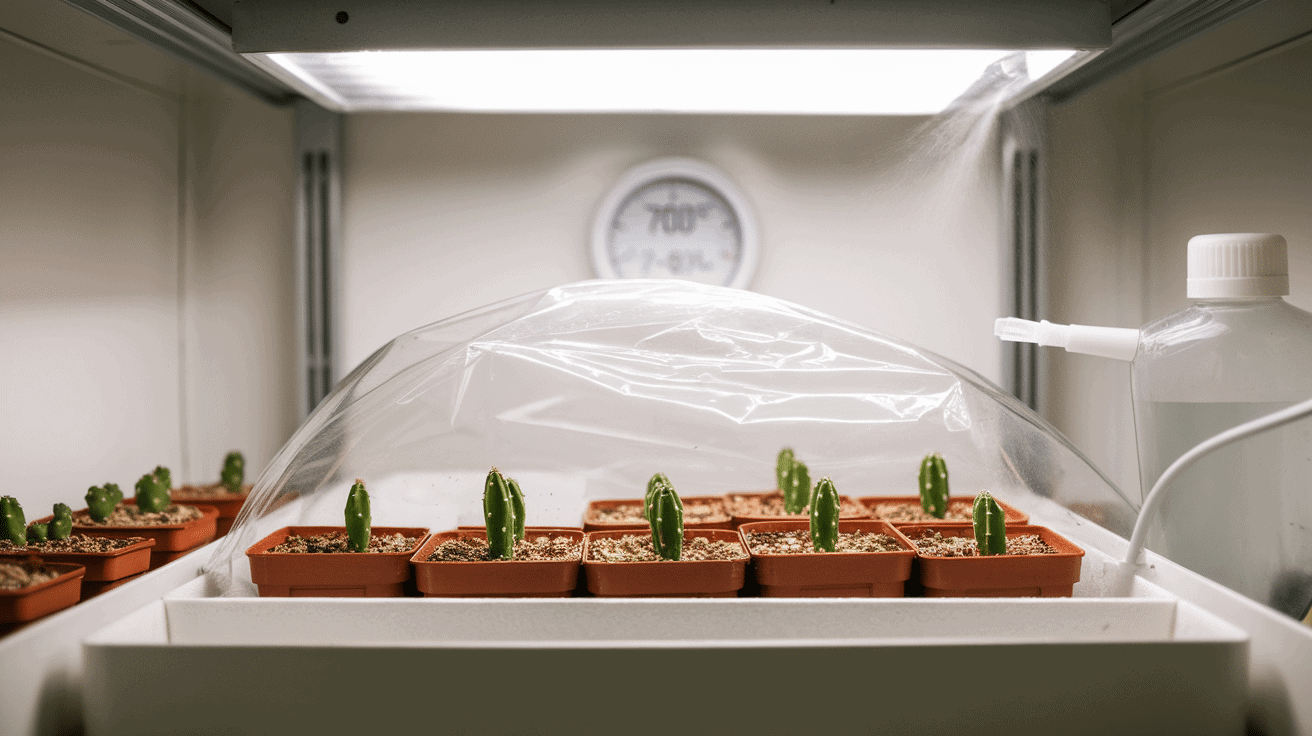Did you know cacti can live for over 200 years? Growing cactus from seed lets you watch these amazing plants from day one.
Many people think cacti are hard to grow, but with the right steps, anyone can do it.
This guide will show you how to pick the best seeds, make the right soil, and care for tiny seedlings. We’ll walk through each step of growing healthy cacti at home – from buying seeds to fixing common problems.
By the end, you’ll have all the know-how to start your cactus garden from tiny seeds.
Understanding Cactus Seeds
Growing cacti from seeds lets you observe the full plant life cycle. Seeds are small but contain everything needed to grow into mature plants.
Let’s examine some basic types and where to find them.
Types of Cactus Seeds
Some cactus types are much easier to grow from seeds than others. Beginners should try Astrophytum seeds, as they grow quickly and don’t need special care.
Opuntia (prickly pear) seeds, which are larger and easier to handle, also work well for new growers since they sprout fast. Both types can grow in basic soil mixes and normal room light. Most will show growth within 2-3 weeks.
Buying Cactus Seeds
You can buy good cactus seeds from plant stores, garden centers, and trusted online shops. Check the package date to make sure the seeds are fresh. Good seeds look plump and feel hard when touched.
Avoid seeds that look very old or damaged. For best results, ask sellers when the seeds were collected. Local plant clubs often share the freshest seeds among members.
Preparing for Planting

Getting the soil right is the key step before you put seeds in pots. Good soil and clean materials help your cactus seeds grow strong. Here’s what you need to know.
Soil Mix Preparation
The best soil for cactus seeds needs good drainage while still holding some water. Mix three parts loam-based potting soil with two parts coarse sand and one part perlite.
This mix lets air reach the roots and water flow through well. You can also use pumice instead of perlite. The soil should feel gritty when you touch it. Avoid regular potting soil as it stays too wet and can rot your seeds.
Sterilization Process
Clean soil stops mold and harmful bugs from killing your new seeds. To sterilize soil, spread it on a baking sheet and heat it in the oven at 180°F for 30 minutes. Let it cool fully before using.
If you prefer not to use heat, you can add a thin layer of fine gravel to the soil after planting. This top layer helps stop mold growth. Some growers use warm water to wet the soil first, as this kills some bad bugs.
Sowing Cactus Seeds

If you have already prepared your soil and are done with the preparation, you can begin sowing the cactus seed into the soil.
Step-by-Step Sowing Instructions
Planting cactus seeds takes care and the right method. These tiny seeds need special handling to grow into healthy plants. Follow these steps to give your cactus seeds the best start:
- Clean your planting tray with mild soap and rinse well
- Fill the tray with cactus soil mix that drains well
- Flatten the soil surface gently with a ruler or card
- Sprinkle seeds thinly across the soil surface
- Mist the soil with water using a spray bottle
- Don’t bury or cover the seeds – they need light to grow
- Place the tray in a warm spot with bright, filtered light
- Keep soil slightly damp but never soggy
After sowing your cactus seeds, you’ll need to focus on a few key areas to help them grow into healthy plants.
The early days after planting are when seeds are most likely to fail, so paying attention to these details will help you get more plants from your seeds.
Best Practices
For the best results when growing cacti from seeds, press them very lightly into the soil without burying them. To help them sprout faster, soak some types of cactus seeds in warm water for 24 hours before planting.
Cover your seed tray with clear plastic wrap to keep moisture in, but poke small holes for airflow. Remove the cover briefly each day to prevent mold growth.
Germination and Early Care

Getting cactus seeds to sprout takes patience and the right care. In the first few weeks, your tiny seeds will turn into baby plants. Here’s how to help them grow well.
Germination Time
Most cactus seeds start to sprout in 1-4 weeks, but some types can take months. Look for tiny green dots on the soil surface – these are your first sprouts. Not all seeds will grow, so plant more than you need.
With fresh seeds, you might see a success rate of 50-70%. Be patient, and don’t give up too soon. Keep checking the soil each day for signs of life, as some seeds pop up when you least expect them.
Temperature and Light Needs
Cactus seeds grow best in warm spots between 70-80°F. Too cold and they won’t sprout; too hot and they might dry out. Place the seed pots in bright light but not direct sunlight, which can cook the seeds.
A spot near a window that gets morning light works well. Some growers use grow lights kept 12 inches above the pots for 14-16 hours daily. If you can, keep the temperature steady day and night.
Humidity
Young cactus seeds need more moisture than adult plants. To trap humidity, cover seed pots with clear plastic wrap or place them in clear plastic bags. This creates a mini-greenhouse effect. Spray water inside the cover once daily to keep the air moist.
Once the seeds sprout, poke small holes in the cover to let in fresh air slowly. After two weeks, remove the cover for longer periods each day until the seedlings can live without it.
Caring for Your Seedlings
Once your seeds have sprouted, they need special care to grow into strong plants. Young cacti are more fragile than adult plants and need your attention. Follow these tips to help them thrive.
1. Watering and Feeding
Water young cactus seedlings when the topsoil feels dry to the touch. Use a spray bottle or small watering can with a fine spout to avoid washing away the tiny plants. During the first three months, keep the soil lightly moist but never soggy.
After the seedlings are two months old, start feeding them with a weak cactus fertilizer (1/4 strength). Apply this mix once a month during spring and summer only. Too much food can harm small plants, so less is better.
2. When to Transplant
Seedlings are ready for new pots when they’ve grown about 1/2 inch tall and have some small spines forming. This usually happens 6-12 months after sprouting. The plants should look firm and healthy, not stretched or pale.
Another sign is roots showing through drainage holes or a seedling looking too big for its current home. Wait until spring or early summer to move them, as this gives them time to settle before winter.
3. Pest Management
Watch for small bugs like spider mites, which look like tiny moving dots on plants. Mealybugs show up as white cotton-like spots. To treat these, wipe plants gently with a cotton swab dipped in rubbing alcohol. Avoid getting alcohol on the soil.
For mold problems, improve air flow around plants and cut back on water. If many seedlings start to shrivel at once, check for root problems by gently removing one plant to look at its roots.
Common Issues when Growing Cactus from Seed
Even with the best care, cactus growers can face some problems. Most issues can be fixed if caught early. Here’s how to spot and fix the most common growing troubles.
Here are the most common issues and how to solve them:
- Failed Germination: Check soil moisture and temperature. Try a warmer spot or a heat mat.
- Overwatering: Reduce water and improve airflow if seedlings are soft or yellow.
- Underwatering: Bottom-soak seedlings if they are shriveled and pale, then set a regular watering schedule.
- Sunburn: Move seedlings to indirect light if they show brown or white patches.
- Slow Growth: Check for poor drainage or rich soil that may be stunting growth.
Expanding Your Cactus Collection
Growing more cacti is easy once you have success with your first batch. You can collect seeds from mature plants in your collection or trade seeds with other growers.
Techniques for taking cuttings work well for many types, too. Just cut a healthy piece, let it dry for a week, and then plant it in dry soil. This gives you new plants that look exactly like the parent without waiting for seeds to grow.
Wrapping Up
Growing cactus from seed takes time, but it brings great joy when those first tiny green dots appear. Now you have all the basics to start your cactus-growing project.
Begin with easy types like Astrophytum or Opuntia. Make sure to use the right soil mix and keep an eye on water and light.
Don’t feel bad if some seeds don’t grow – even pros face this! Try starting with just a few pots to learn what works in your home.
Soon, you’ll have baby cacti to share with friends or add to your plant collection. Why not get some seeds this weekend and start your cactus-growing adventure?













